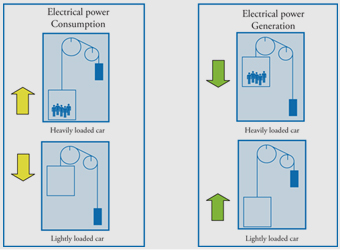Regenerative elevators can generate power on descents when the elevator has a load heavier than the counterweight and on ascents where the counterweight is heavier than the elevator load:

I would imagine that to really capture the effect of regenerative elevators you would have to shift your schedule, so that it is typical when occupants are entering the building (heavily loaded ascents, lightly loaded descents) and negative when occupants are leaving (lightly loaded ascents, heavily loaded descents).
You would have to make an assumption about what percentage of the occupants are going up vs going down throughout the day. When there are more occupants going up you will be using energy and when occupants are going down, you will be generating energy. The energy generated bringing occupants down will roughly mirror the energy used bringing them up, but will also have losses due to the efficiency of the generator.
This is probably a bit overkill for some applications. At the end of the day the meters are all summed up anyway, so applying a percent reduction off the peak load for the elevator schedule is probably a reasonable approach. You just won't get the impact of the time of day impacts on the HVAC system that offsets the heat generated by the elevator motor (which is usually not in a conditioned space anyway).






Thanks for everyone's help.
The exceptional calculation I put together for LEED was accepted, which added over 5% energy cost savings for my project.
The only independent supporting information I found was an ACEEE paper from 2005. Hopefully something newer will be published eventually.
Thanks again.
Is it possible for you to share how you put together your exceptional calculation? Will appreciate any guidance. Thank you.